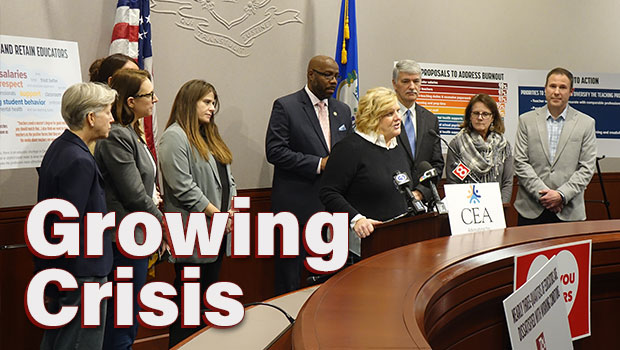Increased salaries, staffing, respect, limits on non-teaching duties would help alleviate growing crisis in our schools.
A growing crisis in Connecticut is impacting students, teachers, and communities and crippling school systems across the state. As Connecticut and the rest of the country continue to suffer from a shortage of educators, a new CEA survey released today finds a rising wave of dissatisfaction with working conditions, high levels of frustration and burnout, and other serious issues are leading to declines in the teacher pipeline and ever-increasing numbers of teachers leaving the profession.
The survey also found that giving thanks to teachers by respecting them as professionals, providing salaries that are competitive and in line with comparable education backgrounds, and limiting non-teaching duties and excessive paperwork would go a long way toward addressing the current problems and helping with the recruitment and retention problem plaguing our schools.
News Conference Speakers:
- CEA President Kate Dias
- Representative-elect Kevin Brown
- Representative Anthony Nolan
- Representative Kathleen Kennedy
- Representative Jillian Gilchrest
- Representative Kate Farrar
- Representative Mary Welander
- CEA Executive Director Donald Williams
- Representative Kathleen McCarty
- Representative Jennifer Leeper
“Teaching has always been a difficult and stressful job with inadequate support and resources to meet students’ needs, a lack of professional respect, subpar compensation, and poor working conditions,” said CEA President Kate Dias. “While educators have been underpaid, undervalued, and under-resourced for years, the COVID-19 pandemic and the relentless attacks on public education and teachers further exacerbated these existing problems, leading to teachers leaving the classroom in droves and fewer students entering the profession, causing snowballing teacher shortages. We must all work together to make substantial changes that will solve these problems.”
According to the survey, nearly three-quarters of educators (74%) say that compared to a few years ago, they are more likely to leave the profession or retire early. That’s up from 55% of teachers surveyed by the National Education Association in January and 38% of teachers surveyed by CEA last fall.
“These numbers are shocking,” said Dias. “They are a direct result of the disrespect, lack of professional working conditions, and low compensation and benefits for what we know is one of the most important jobs in the world, the one that makes every profession possible—teaching.”
The survey of nearly 6,000 Connecticut educators underscores the growing danger in our schools.
- Six in ten educators say public schools are headed in the wrong direction.
- Nearly three-quarters (72%) are dissatisfied with their working conditions.
- Seven in ten are experiencing high levels of frustration and burnout.
Connecticut educators face a number of serious issues.
- Nearly all educators surveyed (98%) identified teacher stress and burnout as their top issue.
- 96% acknowledged staff shortages in schools.
- 95% pointed to the rising number of teachers leaving the profession.
- 93% identified the lack of respect for teachers and students’ mental health.
- 91% pointed to student behavior.
“We need to do more to treat teachers with the respect they have earned and deserve,” said Dias. “The situation in our schools is unfortunately getting worse, and we must address the main issues and create a pipeline that retains and recruits diverse educators into a profession that values its educators and supports and pays them accordingly.”
Top proposals to address burnout and the teacher exodus include:
- Raising educator salaries – 98%
- Limiting non-teaching duties and excessive paperwork – 97%
- Hiring more teachers – 97%
- Providing more planning and prep time – 95%
- Hiring more support staff – 95%
- Providing additional student mental health supports – 94%
- Hiring more counselors and school psychologists – 91%
- Providing additional teacher mental health supports – 91%
“The educator shortage is real and requires immediate attention,” said Dias. “If we want to keep educators in the classroom and encourage people to enter the profession, we need to offer higher compensation, pandemic pension credit, increased autonomy in the classroom, better working conditions, streamlined teacher evaluation, reduced standardized test burden, college debt relief, affordable housing so that educators can live in the communities where they teach, and other incentives to reduce burnout and demonstrate that educators are valued.”
She added, “As we all give thanks this week, I ask everyone to extend that gratitude to the educators who inspired us, who helped make us successful adults, and who continue to serve as role models for our children. During this time when our public schools are in peril, we must ensure that we place significant value on our educators, to keep them in the classroom ensuring a bright future for our children and our state.”
The survey of 5,656 K-12 educators was conducted October 18–25, 2022. It has a margin of error of +/- 1.19% and a 95% confidence level.







